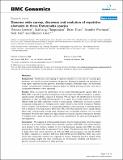Genome wide survey, discovery and evolution of repetitive elements in three Entamoeba species.
Author(s)
Lorenzi, Hernan; Thiagarajan, Mathangi; Haas, Brian J.; Wortman, Jennifer; Hall, Neil; Caler, Elisabet; ... Show more Show less
Download1471-2164-9-595.pdf (908.9Kb)
PUBLISHER_CC
Publisher with Creative Commons License
Creative Commons Attribution
Terms of use
Metadata
Show full item recordAbstract
Background: Identification and mapping of repetitive elements is a key step for accurate gene prediction and overall structural annotation of genomes. During the assembly and annotation of three highly repetitive amoeba genomes, Entamoeba histolytica, Entamoeba dispar, and Entamoeba invadens, we performed comparative sequence analysis to identify and map all class I and class II transposable elements in their sequences. Results: Here, we report the identification of two novel Entamoeba-specific repeats: ERE1 and ERE2; ERE1 is spread across the three genomes and associated with different repeats in a species-specific manner, while ERE2 is unique to E. histolytica. We also report the identification of two novel subfamilies of LINE and SINE retrotransposons in E. dispar and provide evidence for how the different LINE and SINE subfamilies evolved in these species. Additionally, we found a putative transposase-coding gene in E. histolytica and E. dispar related to the mariner transposon Hydargos from E. invadens. The distribution of transposable elements in these genomes is markedly skewed with a tendency of forming clusters. More than 70% of the three genomes have a repeat density below their corresponding average value indicating that transposable elements are not evenly distributed. We show that repeats and repeat-clusters are found at syntenic break points between E. histolytica and E. dispar and hence, could work as recombination hot spots promoting genome rearrangements. Conclusion: The mapping of all transposable elements found in these parasites shows that repeat coverage is up to three times higher than previously reported. LINE, ERE1 and mariner elements were present in the common ancestor to the three Entamoeba species while ERE2 was likely acquired by E. histolytica after its separation from E. dispar. We demonstrate that E. histolytica and E. dispar share their entire repertoire of LINE and SINE retrotransposons and that Eh_SINE3/Ed_SINE1 originated as a chimeric SINE from Eh/Ed_SINE2 and Eh_SINE1/Ed_SINE3. Our work shows that transposable elements are organized in clusters, frequently found at syntenic break points providing insights into their contribution to chromosome instability and therefore, to genomic variation and speciation in these parasites.
Date issued
2008-12Department
Broad Institute of MIT and HarvardJournal
BMC Genomics
Publisher
BioMed Central Ltd
Citation
BMC Genomics. 2008 Dec 10;9(1):595
Version: Final published version
ISSN
1471-2164